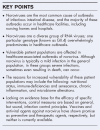Norovirus in healthcare settings
- PMID: 25101555
- PMCID: PMC4154788
- DOI: 10.1097/QCO.0000000000000094
Norovirus in healthcare settings
Abstract
Purpose of review: To provide an overview of the burden of norovirus disease in healthcare settings and the factors responsible for outbreaks in these institutions; to assess progress on interventions aimed at reducing the burden of norovirus disease.
Recent findings: Norovirus outbreaks in healthcare settings are driven by confluence of viral diversity, the built environment, and host factors. Some of these characteristics may be modifiable and the target of successful interventions.
Summary: Most norovirus outbreaks in hospital and residential care institutions are associated with a particular genotype, known as GII.4. The persistence of norovirus is associated with strain diversity, which is driven by immune evasion and viral adaptation to interaction with a variety of human histo-blood group antigens. The healthcare environment presents serious challenges for control, both because of the physical structure of the built space and the high levels of contact among patient populations who may have compromised hygiene. Increased vulnerability among the populations in healthcare institutions is likely to be multifactorial and may include the following: nutritional status, immunodeficiency or senescence, chronic inflammation, and microbiome alterations. Current control measures are based on general infection control principles, and treatment is mainly supportive and nonspecific. Vaccines and antiviral agents are being developed with promising results, but none are currently available.
Figures
References
-
- Gastanaduy PA, Hall AJ, Curns AT, et al. Burden of norovirus gastroenteritis in the ambulatory setting – United States, 2001–2009. J Infect Dis 2013; 207:1058–1065 - PubMed
-
- Payne DC, Vinje J, Szilagyi PG, et al. Norovirus and medically attended gastroenteritis in U.S. children. N Engl J Med 2013; 368:1121–1130 - PMC - PubMed
-
This article demonstrates that after the introduction of rotavirus vaccination programs, norovirus has become the main cause of moderate-to-severe pediatric gastroenteritis in the United States. This is an important reminder for those countries in which vaccines are being rolled as norovirus infection are rarely investigated in paediatric or sporadic cases of gastroenteritis.
Publication types
MeSH terms
Substances
LinkOut - more resources
Full Text Sources
Other Literature Sources
Medical
Research Materials



